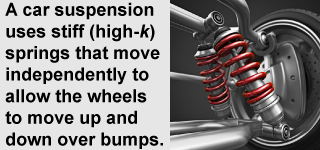|
A spring is a device specifically created to provide controlled amounts of force in many applications. The force exerted by a spring depends on how much it is deformed from its free length. The free length is the length of the spring when it is not exerting any force. The farther the spring is extended or compressed from its free length, the stronger the force the spring exerts on whatever is causing it to extend or compress. 
|
Springs and spring forces
|
Springs come in many types. Three common types are shown below. In each, the restoring force is approximately proportional to the deformation x of the spring relative to its free length. If you deform an ideal spring twice as far, it will produce twice the force. This relationship is known as Hooke’s law and is mathematically expressed as equation (5.4). The force F in equation (5.4) is the force that the spring exerts. It is equal in magnitude, but opposite in sign, to the force exerted by whatever deforms the spring, such as your hand. 
|

|
|
|
| (5.4) | | | F | = | restoring force (N) | | k | = | spring constant (N/m) | | x | = | displacement from equilibrium (m) |
| Hooke’s law for springs
|
|
 The quantity k is called the spring constant, which is the magnitude of the force divided by the amount of deformation. The spring constant has units of force divided by distance. A spring constant of 1 N/m means the spring creates a force of one newton when stretched one meter. The spring constant is a property of the spring itself. A stiff spring deforms very little, even under a large force, and may have a value of k = 100,000 N/m or higher. A loose spring takes very little force to deform and may have a value of k = 100 N/m or less.
The quantity k is called the spring constant, which is the magnitude of the force divided by the amount of deformation. The spring constant has units of force divided by distance. A spring constant of 1 N/m means the spring creates a force of one newton when stretched one meter. The spring constant is a property of the spring itself. A stiff spring deforms very little, even under a large force, and may have a value of k = 100,000 N/m or higher. A loose spring takes very little force to deform and may have a value of k = 100 N/m or less. 
|
The negative sign in equation (5.4) tells you that the force exerted by the spring acts in the opposite direction from the deformation. If you stretch the extension spring in the diagram above, the deformation x is positive. The force is negative, indicating that it is to the left, opposite the deformation. If the deformation is negative, to the left, then the force is positive, to the right. Be careful when using Hooke’s law to use the proper sign for the deformation x. 
|
A spring with a spring constant of 50 N/m is displaced −0.8 m. What is the magnitude of the force exerted by the spring? - 50 N
- 40 N
- 20 N
- 60 N
 |
The answer is b. F = −kx = 0.8 m × 50 N/m = 40 N 
|

